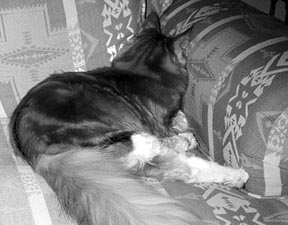Performing standard procedures such as vaccinations or blood tests on a cat that is afraid to visit the veterinarian can be traumatic. For the diabetic cat, blood glucose readings collected in the veterinarians office can be so skewed by the cats stress that they are virtually useless. Under such circumstances, determining how much insulin the cat requires can be problematic.
Human diabetics have been measuring their blood glucose levels at home for years, and now the option of home testing – by using a lancet device and a portable blood glucose meter (PBGM) – is growing more popular with caregivers of diabetic pets.
Test results are more objective at home, says Claudia Reusch, DVM, diplomate of the European College of Veterinary Internal Medicine and head of the Clinic for Small Animal Internal Medicine, University of Zurich, Switzerland. At home, measurements are taken during normal life, and the results are less influenced by stress or lack of food intake, says Dr. Reusch, who co-authored Measurement of Capillary Blood Glucose Concentrations by Pet Owners: A New Tool in the Management of Diabetes Mellitus, which appeared in the Journal of the American Animal Hospital Association (May 1, 2002).
Less Costly, More Effective
For the cat owner on a budget, home BG testing is more economical and particularly useful for a cat that is either difficult to regulate or no longer needs insulin injections. I home test every month or two, just to ensure that we are still on track, says Denise Ethier about her cat, Missy, whose diabetes is now under control without the need for insulin.

288
In the past, testing for glucose in the urine had been the only way to monitor cats at home. For a cat owner, urine samples may be difficult to collect because the cat often uses the litter box when the owner is not looking or asleep – although special cat litters may make the job a little easier.
Capillaries Are Used
Blood is typically collected from the capillaries located in the inside of the cats ear, although other locations may work as well, such as the paw pads. Capillaries are closer to the skin surface than blood vessels from which a veterinarian might draw blood. Portable glucose meters are especially designed for use with capillary blood, says Dr. Reusch.
Its important to ask your cats veterinarian for a hands-on demonstration while in his or her office. But here is one method: Hold the tip of the cats ear between the thumb and index finger and flatten the ear pinna (ear flap) with the other fingers. With the other hand, place the lancet device on the pinna, forming an airtight seal, and press the plunger to move the lancet back and forth once.
When pressure is released, a drop of blood forms on the skin. The test strip in the PBGM is brought into contact with the blood drop. The concentration of glucose in the blood displays on the PBGM.
The owner may use the same lancet device to perform a blood glucose curve (the glucose curve is the plotting in graph form of the results of testing multiple times throughout the day, and tells you visually how your cat is responding to the insulin). Each measurement takes one to two minutes total, and the measuring time of the glucose meter is 30 seconds, says Dr. Reusch.
The subjects in the Zurich study used the glucose meter Glucometer Elite from Bayer and the Microlet Vaculance lancet, also from Bayer. We find that it is easier to generate a big enough blood drop with this lancet, says Dr. Reusch.
Start with Your Veterinarian
If home glucose measuring interests you, talk to your veterinarian to obtain a recommendation for the type of meter to use and detailed instructions on how to use it. Pet owners need very good information on which type to use, how to use, and what mistakes can happen, says Dr. Reusch. For example, with the Glucometer Elite, measuring starts after an acoustic signal, but this signal is given even if the blood drop is too small. The meter will give a wrong result, therefore the veterinarian has to show the owner how much blood is required.
Dr. Reuschs study emphasized the importance of access to veterinary support. Ten of the 14 [dog and cat] owners called for advice one or more times, particularly on the first day. Some had specific questions, while others simply wanted reassurance.
How Cats Respond
Success or failure with home BG testing depends on your cats disposition, your patience, and your creativity. And not all cats adjust to being tested at home. In Dr. Reuschs study, four of the seven cat subjects resisted the procedure – and of course, the cats resistance would artificially alter the readings. Two of the owners were not able to successfully restrain their cats.
Patience is Required
Other problems included the inability to generate negative pressure using the lancet device, and inability to obtain adequate amounts of blood. If your cat resists being restrained or is generally uncooperative, he or she will probably not be a good candidate for home testing.
Perseverence is the key to success. It took me two days to get a large enough blood drop, two weeks to feel comfortable doing the tests, and a month to perfect a daily routine, says Dana Walker, who has been home testing her cat, Raphael, for four years. Now it is easier to give Raphael a blood test at home than it is to give him a pill.


